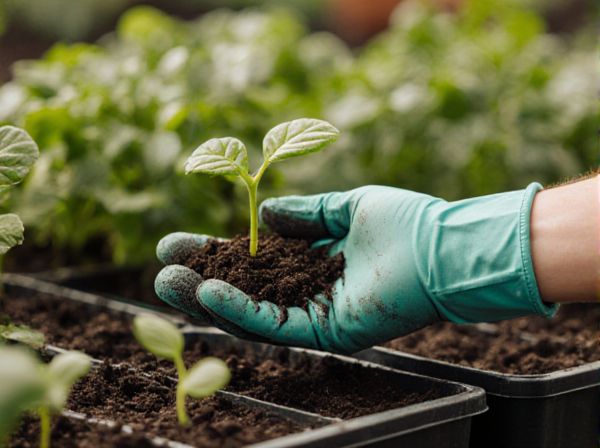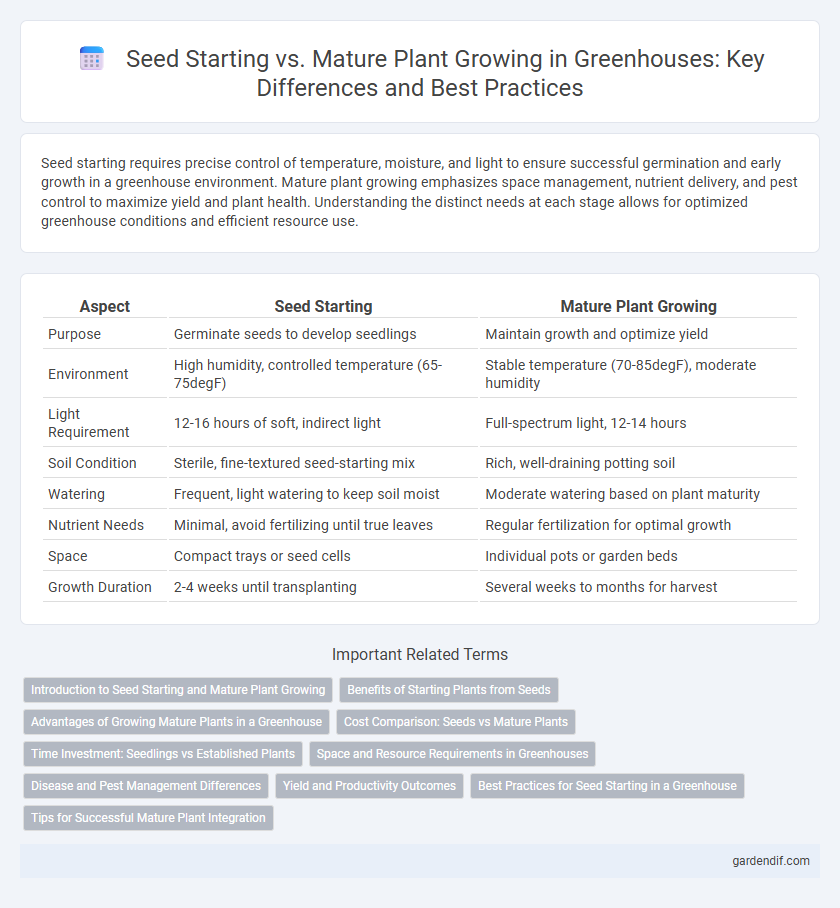
Seed Starting vs Mature Plant Growing Illustration
Seed starting requires precise control of temperature, moisture, and light to ensure successful germination and early growth in a greenhouse environment. Mature plant growing emphasizes space management, nutrient delivery, and pest control to maximize yield and plant health. Understanding the distinct needs at each stage allows for optimized greenhouse conditions and efficient resource use.
Table of Comparison
| Aspect | Seed Starting | Mature Plant Growing |
|---|---|---|
| Purpose | Germinate seeds to develop seedlings | Maintain growth and optimize yield |
| Environment | High humidity, controlled temperature (65-75degF) | Stable temperature (70-85degF), moderate humidity |
| Light Requirement | 12-16 hours of soft, indirect light | Full-spectrum light, 12-14 hours |
| Soil Condition | Sterile, fine-textured seed-starting mix | Rich, well-draining potting soil |
| Watering | Frequent, light watering to keep soil moist | Moderate watering based on plant maturity |
| Nutrient Needs | Minimal, avoid fertilizing until true leaves | Regular fertilization for optimal growth |
| Space | Compact trays or seed cells | Individual pots or garden beds |
| Growth Duration | 2-4 weeks until transplanting | Several weeks to months for harvest |
Introduction to Seed Starting and Mature Plant Growing
Seed starting in a greenhouse involves creating optimal conditions such as consistent warmth, humidity, and light to nurture fragile seedlings until they develop strong roots. Mature plant growing focuses on sustaining established plants with precise water management, nutrient supply, and ventilation to promote healthy growth and maximize yields. Understanding the distinct requirements between seed starting and mature plant stages ensures effective greenhouse management and plant development.
Benefits of Starting Plants from Seeds
Starting plants from seeds in a greenhouse offers greater genetic diversity and disease resistance compared to mature plant growing. Seed starting allows precise control over growing conditions such as temperature, humidity, and light, which promotes stronger root development and healthier seedlings. This method is cost-effective, enabling growers to cultivate a wider variety of plants with higher success rates and better adaptation to the greenhouse environment.
Advantages of Growing Mature Plants in a Greenhouse
Growing mature plants in a greenhouse offers enhanced control over environmental conditions, promoting robust growth and higher yield consistency. Mature plants benefit from reduced vulnerability to pests and diseases compared to seedlings, minimizing crop loss. This method also shortens the overall production cycle, enabling quicker harvests and more efficient space utilization within the greenhouse.
Cost Comparison: Seeds vs Mature Plants
Seed starting in a greenhouse is generally more cost-effective than purchasing mature plants, as seeds are significantly cheaper and allow for a larger variety of crops at a lower initial investment. While seeds require more time, equipment, and care to germinate and grow, the overall expense remains lower compared to buying mature plants, which carry higher purchase costs but reduce growing time. Factoring in long-term yields and potential plant loss, seed starting offers greater economic efficiency for greenhouse growers seeking to maximize profitability.
Time Investment: Seedlings vs Established Plants
Starting plants from seeds requires significant time investment for germination, early growth, and careful monitoring, often taking several weeks before seedlings are ready for transplanting. Mature plants, however, enable immediate growth and quicker yield since they bypass the vulnerable seedling stage, reducing overall cultivation time. Choosing between seed starting and mature plant growing depends on balancing patience and rapid production within greenhouse management.
Space and Resource Requirements in Greenhouses
Seed starting in greenhouses requires minimal space and resources, allowing for dense planting in trays with controlled humidity and temperature to promote germination. Mature plant growing demands significantly more space for root expansion and overall plant development, alongside increased water, nutrient supply, and ventilation to support healthy growth. Efficient resource allocation and spatial planning optimize greenhouse productivity by balancing the intensive needs of mature plants with the compact requirements of seed starting.
Disease and Pest Management Differences
Seed starting in greenhouses requires sterile soil and controlled humidity to prevent damping-off disease, whereas mature plant growing demands vigilant monitoring for pests like aphids and whiteflies that thrive in denser foliage. Seedlings are more vulnerable to fungal infections due to their delicate structure, necessitating precise environmental control and minimal handling. Mature plants benefit from integrated pest management strategies, including biological controls and targeted pesticide applications to mitigate infestations without harming beneficial organisms.
Yield and Productivity Outcomes
Seed starting in a greenhouse promotes higher initial germination rates and uniform seedling development, leading to stronger plant establishment and potentially increased total yield. Mature plant growing often results in quicker harvest cycles but may reduce overall productivity due to limited root adaptation and stress from transplant shock. Optimizing seed starting techniques can maximize long-term yield and improve resource efficiency in controlled greenhouse environments.
Best Practices for Seed Starting in a Greenhouse
Seed starting in a greenhouse requires controlling temperature between 65-75degF and humidity levels around 80% to optimize germination rates. Using sterilized seed trays and high-quality seed-starting mix prevents disease and promotes healthy root development. Providing consistent moisture without waterlogging and ensuring adequate light of 12-16 hours daily supports strong seedling growth for successful transplanting.
Tips for Successful Mature Plant Integration
Mature plant integration in a greenhouse requires careful acclimatization to prevent transplant shock, achieved by gradually exposing plants to the controlled environment. Optimizing light intensity and humidity levels tailored to the specific species ensures robust growth and reduces stress. Implementing consistent watering schedules and nutrient management supports healthy root establishment and maximizes overall plant productivity.
Seed Starting vs Mature Plant Growing Infographic

 gardendif.com
gardendif.com